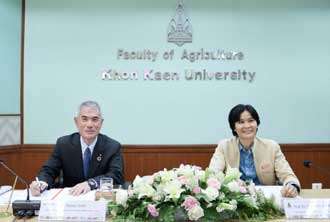 Japan’s Sumitomo Rubber Industries has tied up with Khon Kaen University, a national university of Thailand, for a joint research project on a rubber tree tissue culture technique.
Japan’s Sumitomo Rubber Industries has tied up with Khon Kaen University, a national university of Thailand, for a joint research project on a rubber tree tissue culture technique.
The purpose of the research is to elucidate the mechanism that leads to yield improvement by analysing data on the plant physiological response of rubber trees. Through this research, it says it will accelerate initiatives for sustainable natural rubber procurement.
Although grafting is generally used to propagate rubber tree seedlings at present, it is significantly affected by the stock in terms of growth, disease resistance, and other aspects. Meanwhile, in a tissue culture technique, which Sumitomo says it is working to establish, a part of the tissue of a rubber tree is isolated to be cultured in a test tube and the root and the stem are in the same plant body; this is considered beneficial for growth.
“Actually, it has been confirmed that the seedlings deriving from tissue culture grow faster than the seedlings deriving from general grafting in the early stage of planting (one to two years),” says the firm.
This joint research with Khon Kaen University is aimed at investigating the mechanism that leads to yield improvement by examining the growth and leaf shapes of rubber tree seedlings deriving from tissue culture and those deriving from grafting, obtaining data on plant physiological responses chiefly through the measurement of transpiration, and evaluating the differences.
Another activity is receiving internships from Khon Kaen University within the framework of this joint research.
It will implement initiatives to enhance the sustainability of natural rubber from two perspectives: productivity improvement and odour improvement. For the productivity improvement, various research projects are ongoing that will lead to the promotion of rubber tree growth and the improvement of tapping productivity, while for the odour improvement, it has successfully developed “natural rubber with reduced odour.”
